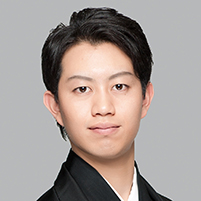Kazutaro Nakamura

Kazutaro Nakamura
Born in 1990 in Tokyo as the eldest son of Ganjiro Nakamura. His grandfather is Tojuro Sakata IV, and his mother is Tokuho Azuma. November 1991, at the Minami-za theater in Kyoto, he made his first appearance on the Kabuki stage under the name Kazutaro Hayashi in the play Kuruwa Bunsho (Love Letters from the Pleasure Quarters) as Fuji-Ya’s Tedai (salesclerk). In January 1995, at the Naka-za theater in Osaka, he gave his debut performance on the Kabuki stage under the name Kazutaro Nakamura in the play Komochi Yamanba (Mountain Ogress with a Child) playing the role of Kintoki (the first child Kintoki). In 2007, at the age of 16, he became the youngest actor ever to perform the masterpiece dance of Kagami Jishi (The Mirror Lion), and in 2010 he played the important role of Ohatsu in the Kabuki classic Sonezaki Shinju (First great love suicide drama) at the same age of 19 as the character Ohatsu. In 2014, Kazutaro was given the name Tokuyo Azuma in his succession to the position as the 7th head of the Azuma school of Nihon Buyo traditional Japanese dance. In 2016, he won the Encouragement Award of the Osaka Culture Festival Awards. In April of the same year, he performed in the play Sandaime Richard (Richard III) written by Hideki Noda and directed by Ong Keng Sen. In March of 2019, he was awarded the Newcomer Award of the Matsuo Performing Arts Awards in the theater category for his performances in plays including Taki no Shiraito (The white threads of a waterfall) and Osome no Nanayaku (Seven Roles of Osome). In 2016, Kazutaro created the shrine maiden’s ceremonial dance performed by the heroine Miyamizu Mitsuha and her sister Yotsuha in the animated film Kimi no Na ha (Your Name) directed by Makoto Shinkai. In 2020, Kazutaro produced and performed in the original online-distribution work ART Kabuki. In June of 2021 he starred in the contemporary play Yoru wa Mijikashi Arukeyo Otome (Night is short, walk on girl). In these ways he has continued to expand his scope of activities to include not only Kabuki but also contemporary theater, and the radio and television media.

